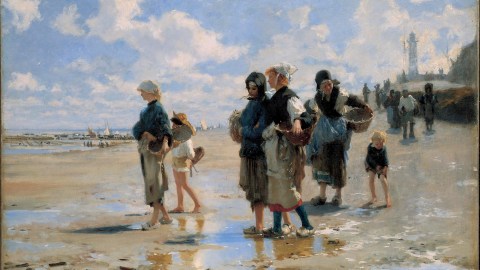Take Me to the Water: Sargent and the Sea at MFA, Houston

Like the first life forms on Earth, the career of John Singer Sargent rose up from the sea. Between 1874 and 1879, when Sargent first emerged from his teens and began his career as an artist, he painted scenes of the sea and shore he witnessed during trips to Brittany, Normandy, Capri, and other Mediterranean spots. The exhibitionSargent and the Sea currently at the Museum of Fine Arts, Houston brings together Sargent’s seascapes together for the first time to allow us to understand how the greatest portraitist of his time literally got his feet wet as a painter.
“The recent discovery of three previously unknown seascapes has confirmed our thesis that in the years 1874-1879 he was primarily a marine painter,” writes Richard Ormond in the introduction to the exhibition catalogue. Linked with previously known yet undervalued water works as well as a scrapbook in the collection of the Metropolitan Museum of Art from this watery period, these paintings show a different side of Sargent. Years before the infamy of Madame X, these works show a portrait of the artist as a young innovator searching for his footing on the shifting sands of the late nineteenth century art world, when tradition first clashed with modernity in the form of Impressionism.
Erica E. Hirshler sees Sargent’s seascapes as a glimpse into the soul of the young artist. Remarking on Sargent’s oils stemming from his transatlantic treks to his “homeland” of America, which he had never visited before, Hirshler writes, “What he painted in oil was the sea—shifting without boundaries, no land in sight…. In a sense these images reflect Sargent’s own position, not just physically, but also psychologically.” A man without a country, Sargent identified with the sea’s fluidity that matched his fluid, transnational self-image. Unpeopled seascapes in the nineteenth century were considered unfinished, just as Sargent considered himself at this time an unfinished artist—a work in progress. The seascapes of Turner, Manet, and Courbet inspired Sargent to paint these “unfinished” works, which seem to have waited until this century to be seen and appreciated.
More “finished” paintings such as 1878’s En Route pour la pêche (Setting Out to Fish) allowed Sargent to test the waters of the marketplace more securely. Sargent painted that work and others in Cancale in northern Brittany. “Occupying a liminal space between land and sea,” Sarah Cash writes in the catalogue, “Cancale was the perfect spot for Sargent—the memories of his recent seaside and transatlantic journeys still fresh—to prepare intensively for the first subject pictures of his career.” In these depictions of the working locals, Sargent took the first steps toward the portraiture that would dominate the rest of his career.
The exhibition concludes with a series of young children bathing and lounging in the sun along the Bay of Naples, which Sargent first visited in 1879. Sargent’s friendship with Antonio Mancini, who frequently painted the young boys of the region, may have spurred his study of these children as a modern approach to the classical nude of antiquity. Again and again, Sargent takes the old and splashes his fresh ideas and amazing technique on it to create something wonderfully new.
Sargent and the Sea refreshes the idea of Sargent the artist by tearing him away from the drawing room stuffiness of many of his portrait subjects to the fresh salt air and sunlit beaches of the beginning of his career, when he seemed more Impressionist than Old Master. Working your way through this revelatory catalogue and exhibition, you feel like a witness at the creation of a genius—a man without a country but who belonged to all the Earth, and its seas.
[Image: John Singer Sargent, American, born Italy, 1856-1925, En Route pour la pêche (Setting Out to Fish), 1878. Oil on canvas. Corcoran Gallery of Art, Washington, D.C., Museum Purchase, Gallery Fund, 17.2.]
[Many thanks to Yale University Press for providing me with a review copy of the catalogue to Sargent and the Sea. Many thanks to the Museum of Fine Arts, Houston for providing me with the image above from the exhibitionSargent and the Sea, which runs through May 23, 2010.]





